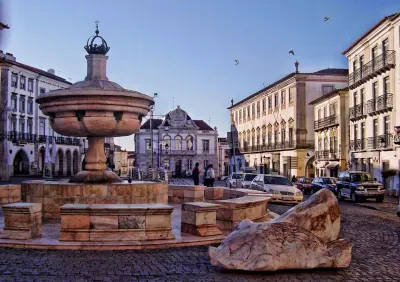
Capela dos Ossos CanStockPhoto/amabrao All rights reserved
Capela dos Ossos interior Ivo Emanuel Gonçalves
Capela dos Ossos corpse 
Capela dos Ossos entrance Ivo Emanuel Gonçalves
Chapel of Bones detail The Medieval Capela dos Ossos (Chapel of Bones) in Evora is a spectacularly morbid celebration of death. As such it is one of Évora's most popular attractions.
Located within the huge, Gothic church of São Francisco, the Chapel of Bones is everything its name suggests. A vaulted ceiling supported by eight columns is about the only part of the chapel that is not covered in the human skulls and bones. It is estimated that there are over 5,000 skulls decorating the chapel many of which were dug up from the many monastic cemeteries in the area.
Apparently the cemeteries were taking up too much space and the idea of moving the bones to a single consecrated space came before one 16th century monk spotted an opportunity. Rather than storing the bones away from view it was seized upon as an opportunity to transmit the message of the inevitability of death and transience of out existence.
To reinforce this message there are various 'death motifs' around the chapel. Over the entrance are the words ''Nós ossos que aqui estamos pelos vossos esperamos" which translates to "We, the bones that are here, await yours.". Other nuggets of fatalistic wisdom include "I leave, but I don't die" and "I die in the light".
Whilst some sources state the bones in Capela dos Ossos the were of Franciscan monks, the sheer number suggests otherwise. Some say that they are the bones of plague victims or soldiers fallen in battle, however it is more likely they are just the remains of generations of the townsfolk of Evora.
If all this isn't sufficiently gruesome for you then there are two dried up corpses hanging from chains - one of a man and the other a child. Again there are legends as to where these remains came from one being they are the corpses of an adulterous husband and the young son who were cursed by his wife. Above this grim display are the words "Melior est die mortis die nativitatis" (Better is the day of death than the day of birth).
Within the chapel is this poem. It is attributed to the parish priest at the time, Frair António da Ascenção:
Where are you going in such a hurry traveler? Stop … do not proceed; You have no greater concern, Than this one: that on which you focus your sight. Recall how many have passed from this world, Reflect on your similar end, There is good reason to reflect If only all did the same. Ponder, you so influenced by fate, Among the many concerns of the world, So little do you reflect on death; If by chance you glance at this place, Stop … for the sake of your journey, The more you pause, the further on your journey you will be.
Address
Praça 1º de MaioSão PedroEvora7000-650Phone
+351 266 704 521
Evora travel guide »
Even from a distance the majestic importance of Evora is apparent, its cathedral dominating the view of the famous white and yellow city as it stands atop a hill surrounded by the vast expanses of the Alentejan plain in southeast Portugal. With over two thousand years of history and, therefore, a variety of cultural and architectural influences, Evora is a real national treasure and certainly…